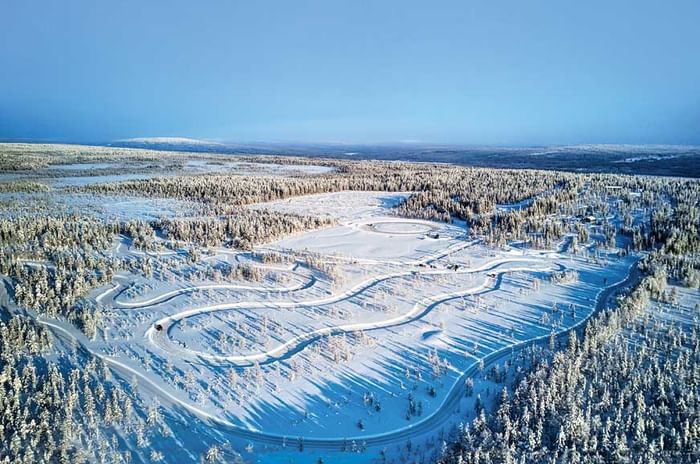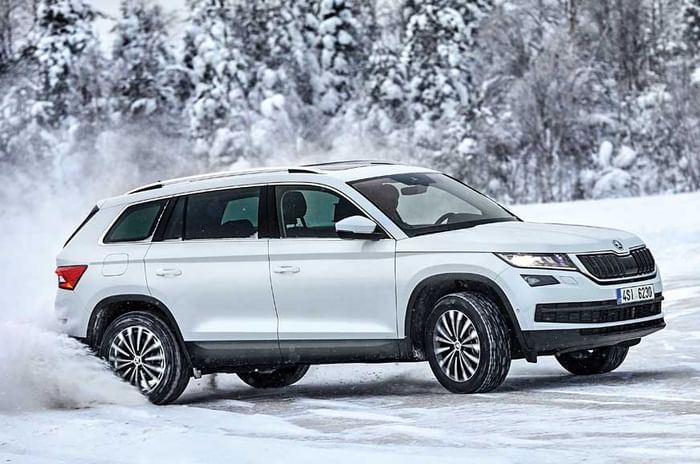We’re in Finland’s Lapland, which is just outside a town called Rovaniemi, better known as the official home to a certain Mr Santa Claus. Our sleighs for the day come in various shapes of Skoda and Santa’s little helpers are here too. Just that they go by the names ‘all-wheel drive’, ‘electronic stability control’, ‘Off-road mode’, and so on. Welcome to the Skoda 4x4 Winter Driving Experience. It’s an event designed to give us a greater understanding of all the hardware and electronics that work behind the scenes to keep us pointed in the right direction when the conditions take a turn for the worse.
Today is a pleasant day I’m told. It’s ‘just’ -12deg C. There’s snow all around and, amidst all the whiteness, it’s hard to make out the tracks we’re to drive on. Skoda’s instructors have broken the day down into sessions, the first of which has us drive the Kodiaq and new Karoq SUV (see box) on a course through the forest. Studded tyres (required by law at this time of the year) are the only performance enhancements over their bog-standard versions. We’re to simply follow a lead car, and are told the SUVs’ Off-Road and Snow modes will see us through the tough stuff.

In brief, Off-Road mode primes the electronic aids for low-traction surfaces, and activates Hill Hold Control and Hill Start Assist. Snow Mode eases the traction control to allow minimal wheelspin (it helps the tyres find grip on snow), and also alters the ABS setting to allow controlled slipping when braking; the logic is that snow piled up ahead of the front wheels itself produces a braking effect. The systems seem to be doing their job well because the Kodiaq is slowly but steadily crunching its way forward on the thick snow, and even steep climbs don’t pose much of a challenge. Spiti valley ready? Perhaps.
Speeds increase dramatically in the next session. I’m passenger to 57-year-old German racer, Hans-Joachim Stuck, whose CV’s achievements section includes a mention of two back-to-back wins at the 24 Hours of Le Mans. He’s demonstrating how reactive Skoda’s all-wheel-drive system (see box) is, and, while at it, he is also giving tips on driving on ice. But I can’t process half of what he’s saying. I’m too busy keeping my innards together on this rollercoaster ride that has us whooshing by dangerously close trees, no more than an arm’s length away, I think. Stuck is balancing the Octavia Combi 4x4 vRS on the throttle into corner after corner, and is incredibly using the entire width of the ice course, narrow as it may be. Racers truly are a different breed.
Skoda has set up a competition of its own here for our gathered troop of motoring journos. It’s a drag race between two Superbs. Both are identical in power and both use the same manual gearbox too. It’s just that one is a front-wheel drive and the other is an all-wheel drive. No prizes for guessing which one is quicker on the carpet of ice that is doubling as the drag strip. By the time the front-wheel-drive Superb gets going, the all-wheel-drive one is already a car length or two ahead. The exercise is really revealing and it shows just how much of a difference distributing power to all four corners can make to traction in a low-grip environment as this.

A comforting hot chocolate or three later, it’s time for the ice-handling course. Lined up for us are 4x4 Superbs, Octavias and Fabia Scouts, and our job is to progressively reduce the level of electronic intervention every couple of laps. Sounds like a plan. It’s all electronics on at first and the feeling I get is that the car always has my back. Sure, the stability control light on the instruments console flashes like a Las Vegas slot machine when I try to do something silly but the electronics are quick to cut or reassign power until they’re convinced I’m back in charge. Sport mode makes the electronics a bit more lenient but the real contrast is with traction control and ESP switched off. There’s wheelspin on all but the most measured throttles, I can feel a disconnect between commands at the steering and execution by the car, and suddenly the whole driving experience gets a lot busier. I can’t say it isn’t fun to tango with the car and have it switch direction like a pendulum on the hairpins, but then again, we’re in a closed environment with soft snow banks on either side of the course to break a slide should things go too far, which they do. In the real world, matters could be a whole lot darker.
The day ends on a high. I’ve just drifted a 1.7-tonne, all-wheel-drive Kodiaq around an ice circle. It looks mega but I’ll let you in on a secret. It’s not all that hard to pull off a drift on ice. Switch off all electronic aids, chuck the car into a slide, and all you need to do to hold it there is to be gentle and precise with steering and throttle inputs. It is the easiest way to feel like a driving god.
In all, the day’s driving has me convinced of the efficacy of all-wheel drive and the whole host of modern driver aids in really frigid and testing conditions. They really are the difference between enjoying the scenery and becoming part of it. So, if you are a regular to the Himalayas or even fancy the idea of venturing off-road, a car with AWD, at the very least, should be a no-brainer for you. And maybe, just maybe Santa should have a look too.
All we’ll drive

All Skoda 4x4 models, the India-made Kodiaq included, make use of an electronically controlled multi-plate clutch-based all-wheel-drive system. Natively, the setup channels 96 percent engine torque to the front axle for best efficiency, but, as conditions demand, up to 90 percent of engine power can be sent to the rear axle too, or in extreme cases, up to 85 percent to any of the four wheels. The transition takes place in real time and in a matter of milliseconds. In addition to the all-wheel-drive system, Skoda 4x4s also get EDL or electronic differential lock on both front and rear axles. EDL slows a spinning wheel and transfers torque to the wheel with traction.
Karoq for us folk

The Karoq SUV was one of the Skoda models at our disposal and is one of great interest to us because it comes to India by early 2019. The five-seater Karoq is a replacement for the Yeti but the look is far more conventional than its quirky predecessor. The lines are neat, clean and modern Skoda, and there’s more than a hint of the Kodiaq to the styling treatment too. On the inside, the dash is quite conventional in its looks, but everything is well put together and feels upmarket. Space in the back, however, is adequate but not class-leading, though the Karoq does offer plenty of room for luggage. It is likely to be offered with petrol and diesel engine options, with a choice of gearboxes. All-wheel drive is a possibility too. Skoda can’t bring its Jeep Compass-fighter a day too soon.


















































